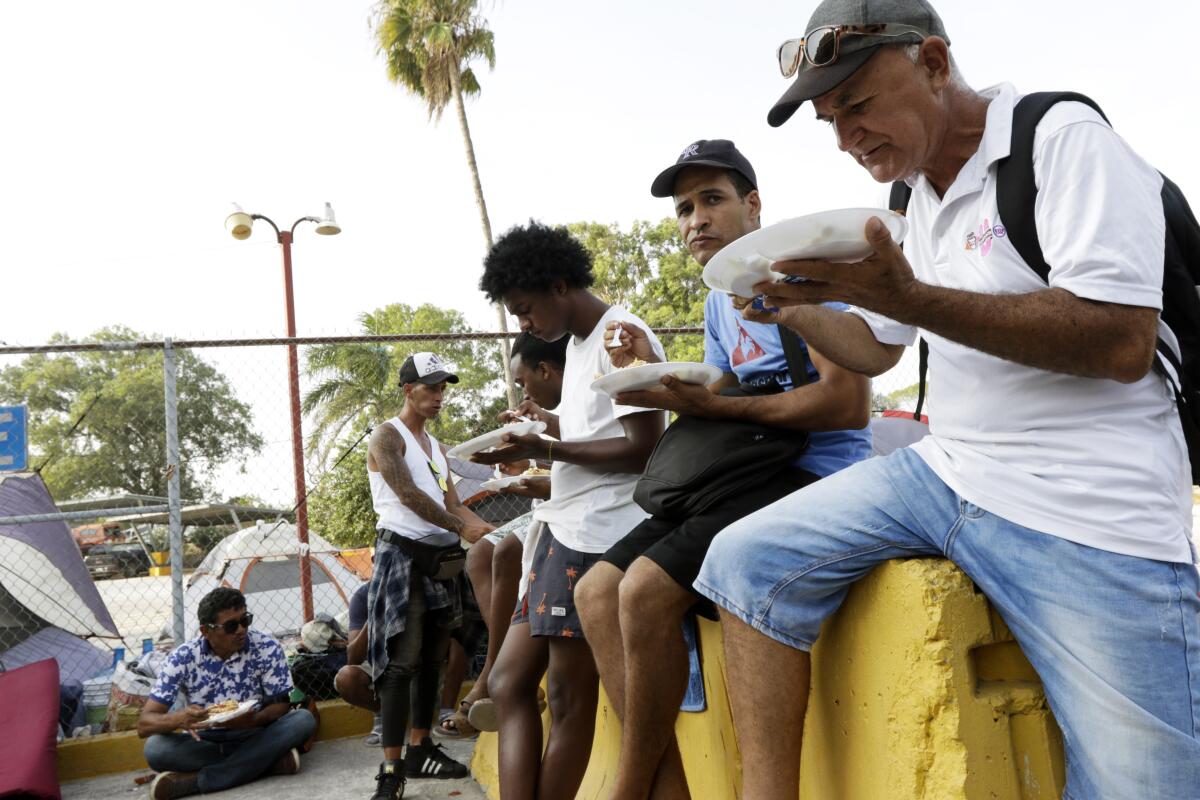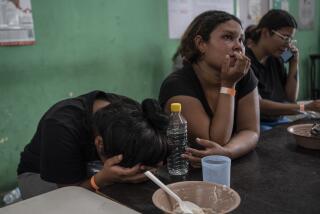ACLU sues to stop new policy blocking asylum seekers at U.S.-Mexico border

Ciudad Juarez, Mexico — The American Civil Liberties Union filed a lawsuit in federal court Tuesday on behalf of several California immigrant advocacy groups to stop a new Trump administration rule that would block virtually all migrants from claiming asylum at the U.S.-Mexico border.
The lawsuit, filed in San Francisco hours after the new asylum rule took effect, argues that it violates the Immigration and Nationality Act of 1965 and was implemented unlawfully. The lawsuit asks that a judge issue an injunction against the rule.
“This is the Trump administration’s most extreme run at an asylum ban yet. It clearly violates domestic and international law, and cannot stand,” said lead attorney Lee Gelernt, New York-based deputy director of the ACLU’s Immigrants’ Rights Project.
The lawsuit was filed on behalf of the Central American Resource Center in Los Angeles, Al Otro Lado in San Diego, East Bay Sanctuary Covenant and the Innovation Law Lab, which works in several states.
Gelernt said that even with the new rule in force, migrants should still be able to apply for asylum or ask immigration judges to halt their deportations under other laws that protect them from being returned to danger in their home countries.
The new rule would deny asylum to migrants who failed to apply for protection in at least one country they crossed on their journey north. Hondurans and Salvadorans would have to apply and be denied asylum in Guatemala or Mexico before they were eligible in the U.S.; Guatemalans would have to apply and be denied asylum in Mexico.
The influx of 688,375 migrants at the border this year has largely come from Central America, and most went to Texas. In Texas’ Rio Grande Valley, the busiest stretch of the border for illicit crossings, 43,197 migrants were caught attempting to illegally enter last month, almost triple the number caught in the same area in June 2018, according to the Border Patrol.
In El Paso, another hot spot, the Border Patrol caught 18,878 migrants attempting to cross illegally last month, more than five times as many as the previous June. Shelters have become crowded this year on both sides of the border, with thousands of migrants waiting to cross the border legally from Juarez this week.
At the main border crossing in Juarez on Tuesday, confusion reigned as about 150 mostly Cuban migrants tried to find out whether they would be able to request asylum.
Elaine Bolaños, 30, stood in the hot sun with an overstuffed backpack slung over one shoulder and a worried look on her face. She left Cuba earlier this year with her son because she said she disagreed with the nation’s communist government. Her ex-partner, her son’s father, fled to Orlando five years ago and had paid for them to try to join him in Florida.
She and her son, a lanky 10-year-old named Yussett, flew first to Nicaragua and then traveled through Honduras and Guatemala by bus before arriving in Mexico. They had waited three months in Juarez for their number — 12,063 — to be called by Mexican immigration officials, who have helped administer a U.S. policy known as metering that allows only a small number of migrants to seek asylum at official points of entry each day.
Bolaños said she hadn’t felt safe in any of the places she had journeyed through, including Juarez, a city of 1.3 million known for its violence, where nine people were slain Sunday. She had holed up in a cheap hotel near the border, rarely leaving for fear of being robbed or assaulted.
“It’s been very, very difficult,” said Bolaños, her eyes welling with tears. “I didn’t know it would be this hard.”
At about 10 a.m., an official from Grupo Beta, a Mexican immigration agency, yelled 10 numbers from the waiting list, promised to announced more Wednesday and disappeared. Bolaños, 12 numbers away from being called, was disappointed but optimistic that asylum seekers were still being allowed into the U.S.
The 10 migrants whose numbers had been called filed into a small office to be processed by Mexican officials who led them, single file, onto the border bridge to El Paso.
Among them was another Cuban migrant, Anais, 53, who declined to give her last name because she fears her family back home could face retribution from Cuban authorities.
She had waited for three months at the border with her 14-year-old son and 21-year-old daughter and said she had no idea what was going to happen to them in El Paso.
“Everything is unclear,” she said. “We don’t know how the new policy will affect us.”
At the Chihuahua state government office, steps from the border, Mexican officials continued to distribute numbers on the waiting list to migrants who hoped to seek asylum in the U.S. They were at 17,540 on Tuesday, which meant that nearly 5,500 migrants were still waiting, though some may have already given up and returned home or crossed the U.S. border illegally.
Migrants who lined up to receive numbers on the waiting list to cross from Tijuana into San Ysidro said they had not heard about the new asylum rule.
Guatemalan migrant Oscar Adolfo Chali said he had never considered asking for asylum in Mexico.
“That’s not something that makes any sense to us,” said Chali, who spent two months traveling north to the border with his sister-in-law and her two children. “We had to escape our country; we weren’t ourselves over there because we were being persecuted.”
Sandra Wilson, 21, has been waiting in Tijuana for three months hoping to seek asylum in the U.S. after fleeing Cameroon, staying in a rented apartment with 50 other people.
“We are really tired; we don’t have money to even eat,” Wilson said, noting she and her family, part of the English-speaking minority in Cameroon, fled oppression by the French-speaking government.
“They shoot anyone there; the military just kills,” she said.
Seeking asylum in Mexico wasn’t an option, Wilson said, because, “We can’t live here. We can’t speak Spanish, so we can’t work.”
On Tuesday, for the first time in days, a worker coordinating the asylum waiting list appeared at the border crossing with a microphone, and Wilson suddenly thought she might still make it into the U.S.
“They’re calling the numbers!” she cried, drawing as close as she could to the crossing’s metal fence.
The worker called about 15 people’s numbers, then stopped at 2,703 — three numbers short of Wilson.
Wilson shook her head and threw her hands up.
“They just don’t call enough numbers,” she said.
Jennifer Quigley, director of refugee advocacy at Human Rights First, said the new asylum rule appeared to apply only to asylum applications filed from Tuesday on, not to existing cases, including the roughly 20,000 in the “Remain in Mexico” program. The Trump administration created the program this year, forcing some asylum seekers to wait in Mexico while their cases proceed in U.S. immigration court, returning only for court hearings.
While U.S. asylum cases can take years to resolve due to a nationwide backlog, Quigley noted the delay was just as bad in Mexico: Asylum applications this year were expected to reach 60,000, up from 15,000 two years ago.
South Texas lawyer Jodi Goodwin visits the nearby border crossing in Matamoros weekly and said it was unclear Tuesday how the new rule would affect asylum seekers there. Goodwin had spoken to immigrants who decided to cross the Rio Grande illegally this week, despite several recent deaths of migrants parents and children attempting to cross the river illegally.
“There were lots of people intimating to me that they were crossing. They’re tired of changes in the policies when they’re legitimately waiting for months,” Goodwin said.
Times staff writers Hennessy-Fiske and Linthicum reported from Houston and Ciudad Juarez, respectively, and special correspondent McDonnell Nieto del Rio from Tijuana. Special correspondents Ingrid Giese in Ciudad Juarez and Edyra Espriella in Matamoros contributed to this report.
More to Read
Sign up for Essential California
The most important California stories and recommendations in your inbox every morning.
You may occasionally receive promotional content from the Los Angeles Times.












